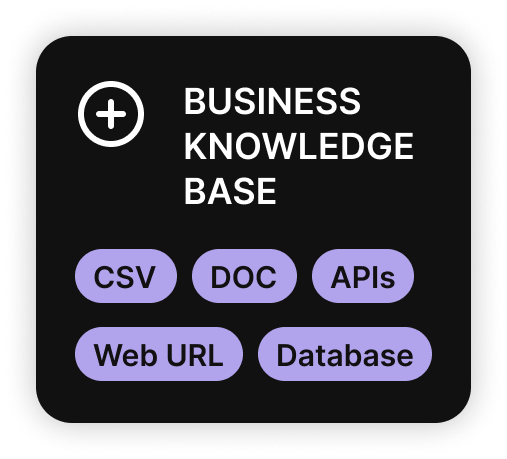The Complete Guide to Building a Knowledge Base for Your AI Agent

The Complete Guide to Building a Knowledge Base for Your AI Agent
A well-structured knowledge base is the foundation of any successful AI agent. It's what transforms a basic chatbot into an intelligent assistant that can provide accurate, helpful, and contextual responses to your customers. In this comprehensive guide, we'll walk you through the process of creating a knowledge base that will make your AI agent truly exceptional.
Why a Knowledge Base Matters for AI Agents
Your AI agent is only as good as the information it has access to. A comprehensive knowledge base ensures that your AI can:
- Provide Accurate Information: Give customers the right answers every time
- Handle Complex Queries: Understand and respond to nuanced questions
- Maintain Consistency: Deliver uniform responses across all interactions
- Scale Efficiently: Handle more inquiries without human intervention
- Improve Over Time: Learn from interactions to provide better service
Step 1: Planning Your Knowledge Base Structure
Identify Your Content Categories
Start by organizing your information into logical categories:
- Product Information: Features, specifications, pricing
- Service Details: How-to guides, troubleshooting, FAQs
- Company Information: Policies, contact details, business hours
- Industry Knowledge: Trends, best practices, relevant insights
Define Your Target Audience
Consider who will be interacting with your AI agent:
- Customers: Need product and service information
- Prospects: Want to understand your value proposition
- Partners: May need technical or business information
Step 2: Content Creation and Organization
Start with Frequently Asked Questions (FAQs)
Begin by documenting the questions your customers ask most often:
- Collect Questions: Review customer support tickets, emails, and chat logs
- Categorize by Topic: Group related questions together
- Write Clear Answers: Use simple, direct language
- Include Examples: Provide real-world scenarios when helpful
Create Comprehensive Product Documentation
For each product or service, include:
- Overview: What it is and what it does
- Features: Key capabilities and benefits
- How to Use: Step-by-step instructions
- Troubleshooting: Common issues and solutions
- Pricing: Cost information and plans
Develop Process Documentation
Document your business processes:
- Order Processing: How orders are handled
- Returns and Refunds: Policies and procedures
- Technical Support: Escalation processes
- Account Management: How customers can manage their accounts
Step 3: Content Optimization for AI
Use Clear, Consistent Language
- Avoid Jargon: Use simple, everyday language
- Be Consistent: Use the same terms throughout
- Write Concisely: Get to the point quickly
- Use Active Voice: Make content more engaging
Structure Information for Easy Retrieval
- Use Headers: Organize content with clear headings
- Create Lists: Break down complex information
- Include Keywords: Use terms your customers search for
- Add Context: Provide background information when needed
Include Multiple Response Formats
Prepare different ways to answer the same question:
- Short Answers: For quick queries
- Detailed Explanations: For complex topics
- Step-by-Step Guides: For how-to questions
- Visual Aids: When possible, include images or videos
Step 4: Implementing Your Knowledge Base
Choose the Right Format
Consider how your AI agent will access the information:
- Markdown Files: Easy to maintain and version control
- Database: For dynamic, frequently updated content
- API Integration: For real-time information
- Hybrid Approach: Combine multiple sources
Organize for Easy Access
- Hierarchical Structure: Use categories and subcategories
- Tagging System: Add relevant tags to each piece of content
- Cross-References: Link related information
- Search Optimization: Include relevant keywords
Step 5: Testing and Validation
Test with Real Questions
- Use Customer Data: Test with actual customer inquiries
- Simulate Scenarios: Create realistic conversation flows
- Validate Accuracy: Ensure responses are correct
- Check Completeness: Make sure all topics are covered
Gather Feedback
- Monitor Interactions: Track how customers interact with your AI
- Collect Feedback: Ask customers about their experience
- Analyze Gaps: Identify areas where the AI struggles
- Iterate and Improve: Continuously update your knowledge base
Step 6: Maintenance and Updates
Regular Content Reviews
- Schedule Reviews: Set regular intervals for content updates
- Update Information: Keep product and service details current
- Add New Content: Document new features and services
- Remove Outdated Information: Delete obsolete content
Performance Monitoring
- Track Success Rates: Monitor how often the AI provides helpful responses
- Identify Knowledge Gaps: Find topics that need more coverage
- Analyze User Behavior: Understand what customers are asking about
- Optimize Based on Data: Use insights to improve your knowledge base
Best Practices for Knowledge Base Management
1. Keep It Simple
Don't overcomplicate your knowledge base. Focus on clarity and ease of use.
2. Be Consistent
Use consistent terminology, formatting, and structure throughout.
3. Update Regularly
Keep your knowledge base current with the latest information.
4. Test Continuously
Regularly test your knowledge base with real customer questions.
5. Gather Feedback
Listen to customer feedback and use it to improve your content.
6. Use Analytics
Track how your knowledge base is performing and identify areas for improvement.
PurpleAiX Knowledge Base Features
PurpleAiX provides powerful tools for building and managing your knowledge base:
- Easy Content Upload: Upload documents, PDFs, and other files
- Smart Organization: Automatically categorize and tag content
- Real-time Updates: Keep your knowledge base current
- Analytics Dashboard: Track performance and identify improvements
- Multi-format Support: Handle text, images, and structured data
Getting Started
Building a comprehensive knowledge base takes time and effort, but the results are worth it. A well-structured knowledge base will make your AI agent more intelligent, improve customer satisfaction, and reduce support costs.
Start by identifying your most common customer questions and creating clear, helpful answers. Then, gradually expand your knowledge base to cover more topics and scenarios. Remember, this is an ongoing process that requires regular maintenance and updates.
Ready to build a powerful knowledge base for your AI agent? Get started with PurpleAiX and see how easy it is to create intelligent, helpful AI agents that your customers will love.